Lung Cancer
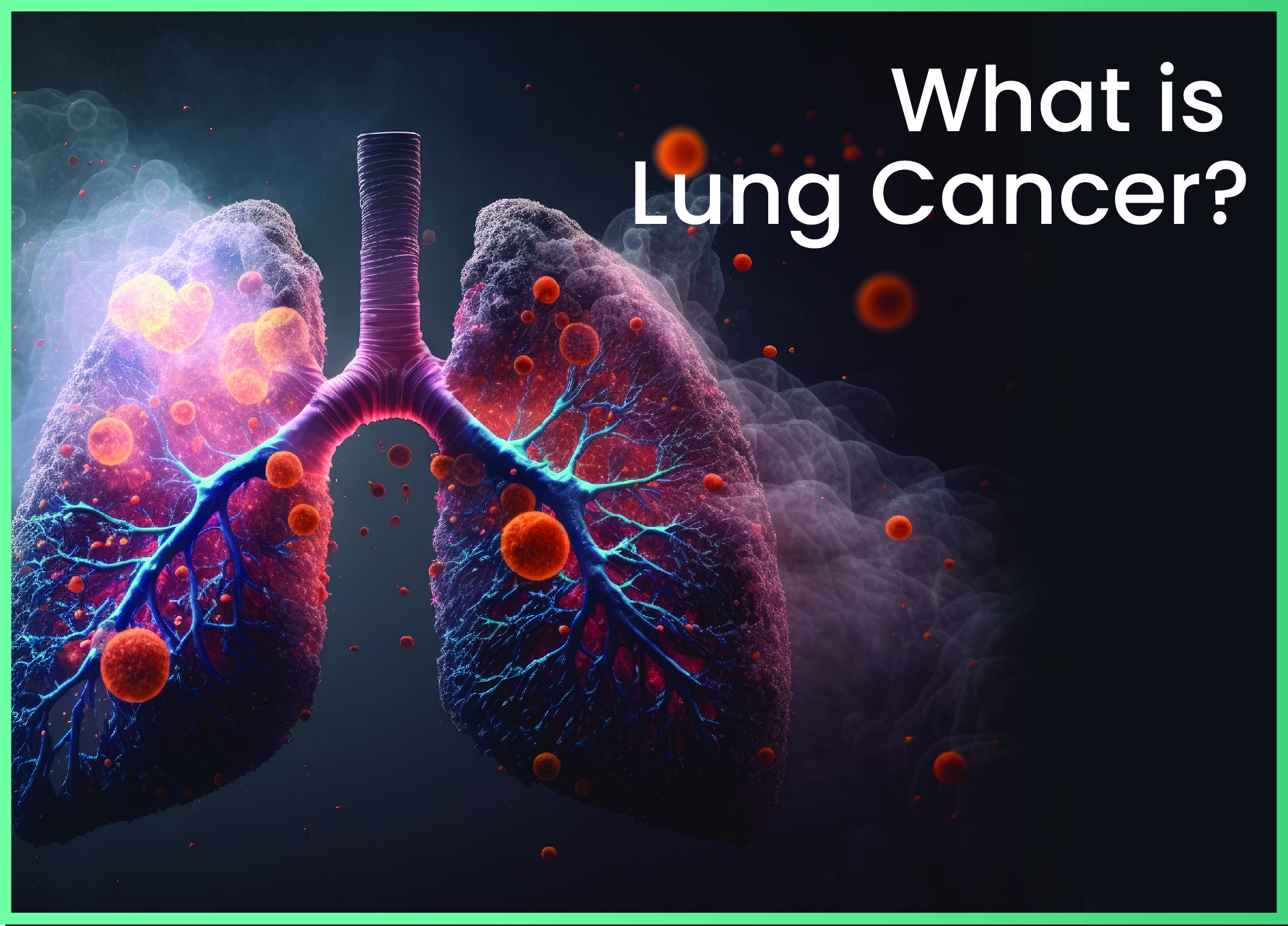
Lung cancer is one of the most common types of cancer seen around the world. It happens when cells in the lungs start growing abnormally and uncontrollably. If not found and treated in time, it can spread to other parts of the body.
What is Lung Cancer?
Lung cancer starts in the lungs. Lungs are two organs in your chest that help you breathe and supply oxygen to your body. When cells in your lungs start to grow out of control, they form a lump or tumor. This tumor can make it hard for you to breathe properly and may spread to other parts of the body if not treated early.
Types of Lung Cancer
1. Small Cell Lung Cancer (SCLC):
This type is less common but grows faster and spreads quickly. It is strongly linked to smoking.
2. Lung Carcinoid Tumors:
These are rare and grow slowly. They are often found early and have a better outcome.
3. Non-Small Cell Lung Cancer (NSCLC):
This is the most common type and grows more slowly than the other type. It has three main subtypes:
- Adenocarcinoma: Starts in cells that make mucus; common in smokers and non-smokers.
- Squamous Cell Carcinoma: Usually linked with smoking; found in the center of the lungs.
- Large Cell Carcinoma: Can grow anywhere in the lungs and spreads quickly.
Who is at Risk of Lung Cancer?
Some people have a higher chance of getting lung cancer. These are called risk factors. Having one or more of these doesn’t mean you will surely get lung cancer, but your chances are higher.
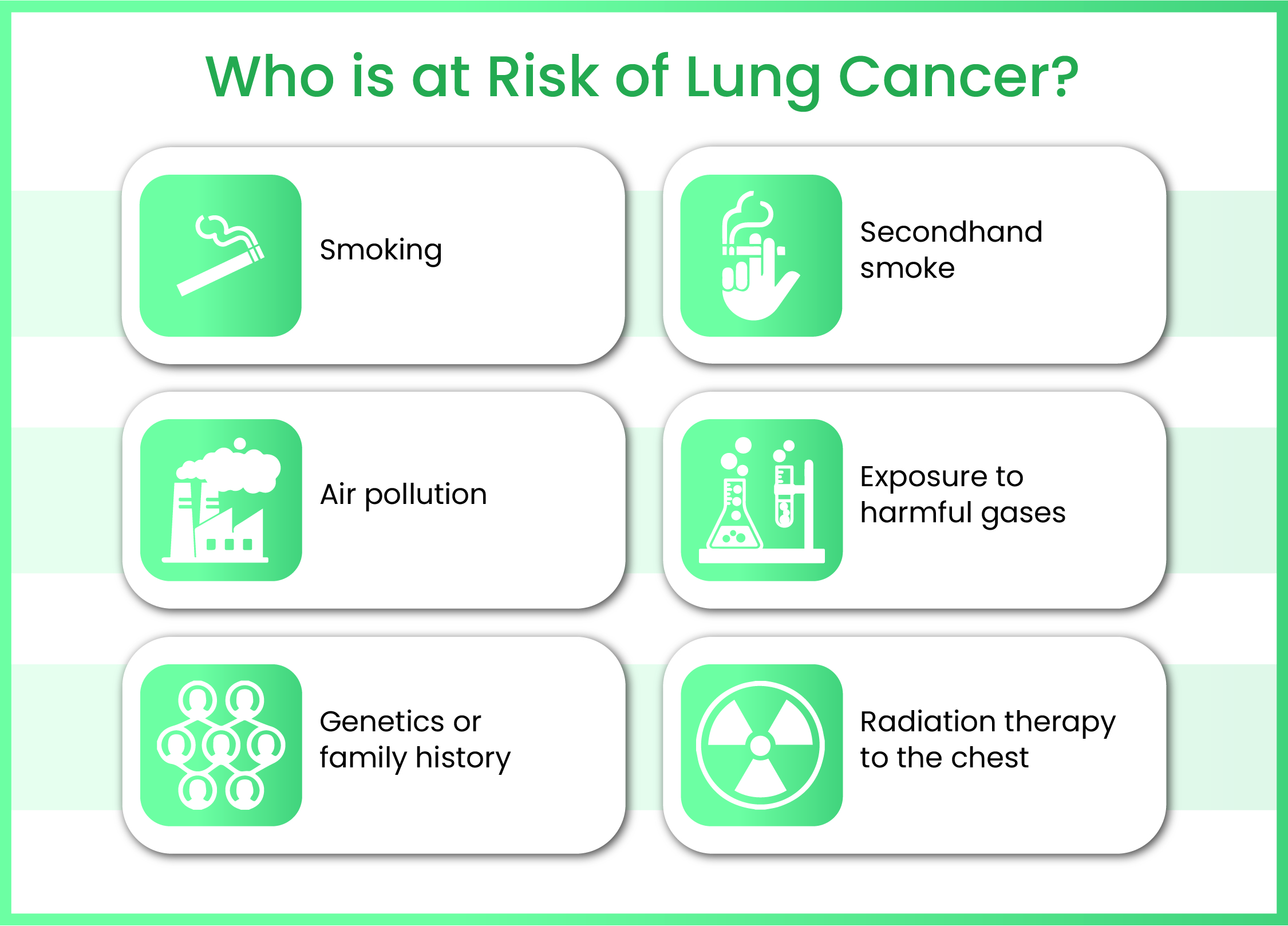
1. Smoking
The most well-known and dangerous risk factor is smoking. In fact, smoking is responsible for the majority of lung cancer cases. This includes not just cigarettes but also bidis, cigars, hookahs, and vaping. When tobacco is burned, it produces toxic chemicals that damage the cells lining the lungs. Over time, this damage can lead to uncontrolled cell growth – which is how cancer begins. The longer and more heavily someone smokes, the greater their risk. However, even people who have quit smoking remain at a slightly higher risk compared to those who never smoked.
2. Secondhand Smoke
The smoke you inhale when someone else is smoking near you. Even if you’ve never smoked a single cigarette, just being around smokers regularly – whether at home, work, or in public places – can harm your lungs. This makes secondhand smoke a serious concern, especially for children and non-smokers living with smokers.
3. Air Pollution
Air pollution is another growing cause of lung cancer, especially in cities like Mumbai and other densely populated areas. Breathing in polluted air every day, which contains harmful particles from vehicle exhaust, factories, construction sites, and burning garbage, can irritate the lungs over time. Long-term exposure to this kind of polluted air can increase the risk of lung cancer, even in non-smokers.
4. Exposure to Harmful Gases
Some people are also exposed to dangerous substances at their workplace. For example, miners, construction workers, and factory employees might inhale chemicals like asbestos, arsenic, diesel exhaust, or radon gas. These substances can damage lung tissue and increase the chances of cancer. Safety measures like protective equipment and proper ventilation are very important in such environments, but not everyone may have access to them.
5. Genetics or Family History
If your parents, siblings, or close relatives have had lung cancer, you may have a slightly higher risk of getting it too. This could be due to shared environmental exposures, genetic mutations passed down in families, or both. However, it’s important to understand that having a family member with lung cancer does not guarantee that you will develop it too – it simply means you should be more careful with screenings and lifestyle choices.
6. Radiation Therapy to the Chest
People who have had radiation therapy to the chest for other cancers, such as breast cancer or lymphoma, might also have a higher risk of developing lung cancer later in life. This is because radiation, while helpful in treating cancer, can also damage normal cells and increase the chances of new cancers forming over time.
Signs and Symptoms of Lung Cancer
In the early stages, lung cancer may not show any symptoms. That’s why it’s often found late. But there are some warning signs you should not ignore:
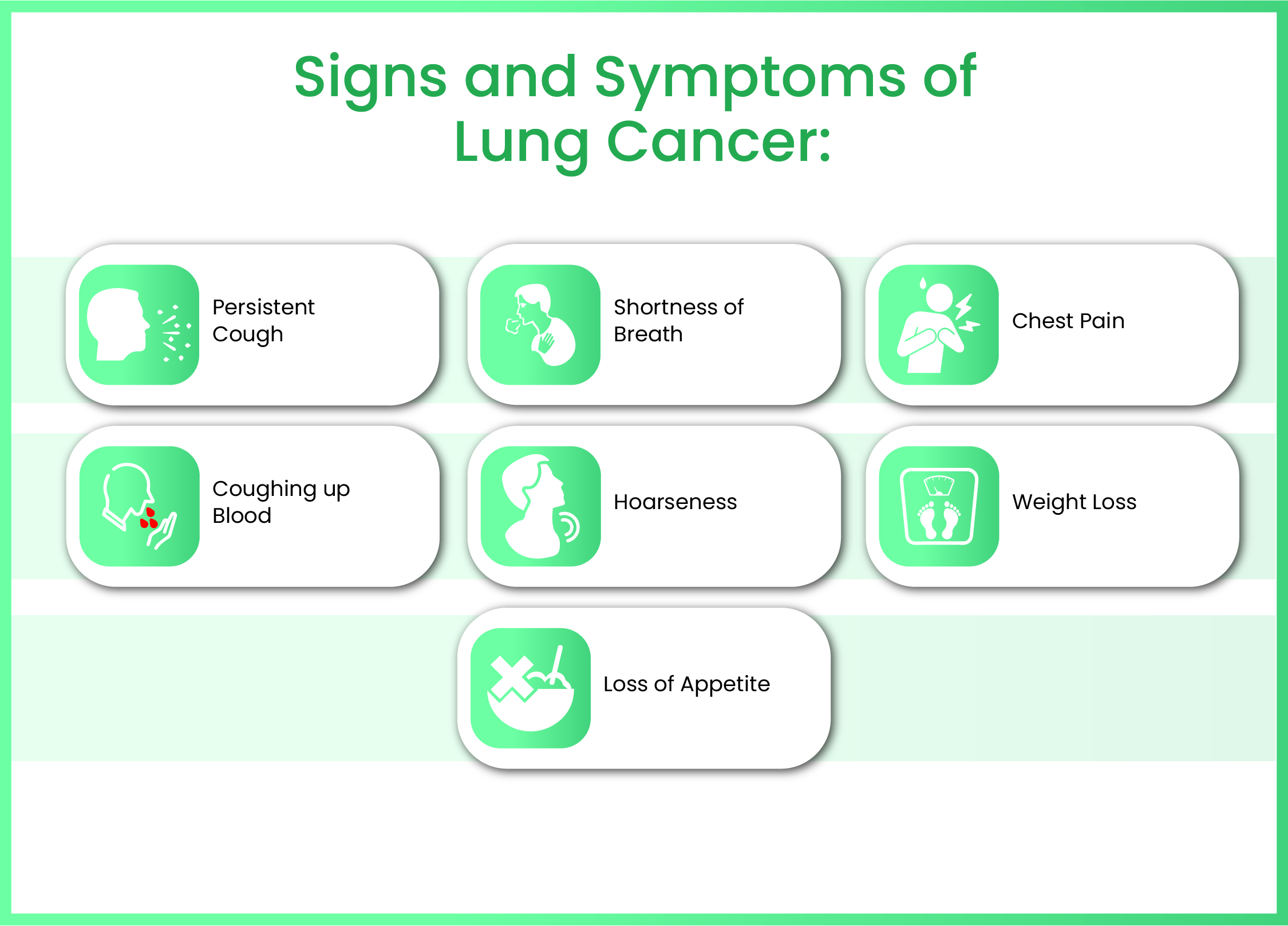
Persistent Cough: A cough that doesn’t go after a few weeks, or a cough that worsens over time.
Shortness of Breath: Difficulty breathing, especially when active or lying down.
Chest Pain: Discomfort in the chest that may worsen with breathing or coughing.
Coughing up Blood: Hemoptysis, or coughing up blood or bloody mucus.
Hoarseness: A change in voice or a persistent hoarseness.
Weight Loss: Unexplained or unintentional weight loss.
Loss of Appetite: Decreased appetite or a feeling of fullness after eating.
How is Lung Cancer Diagnosed?
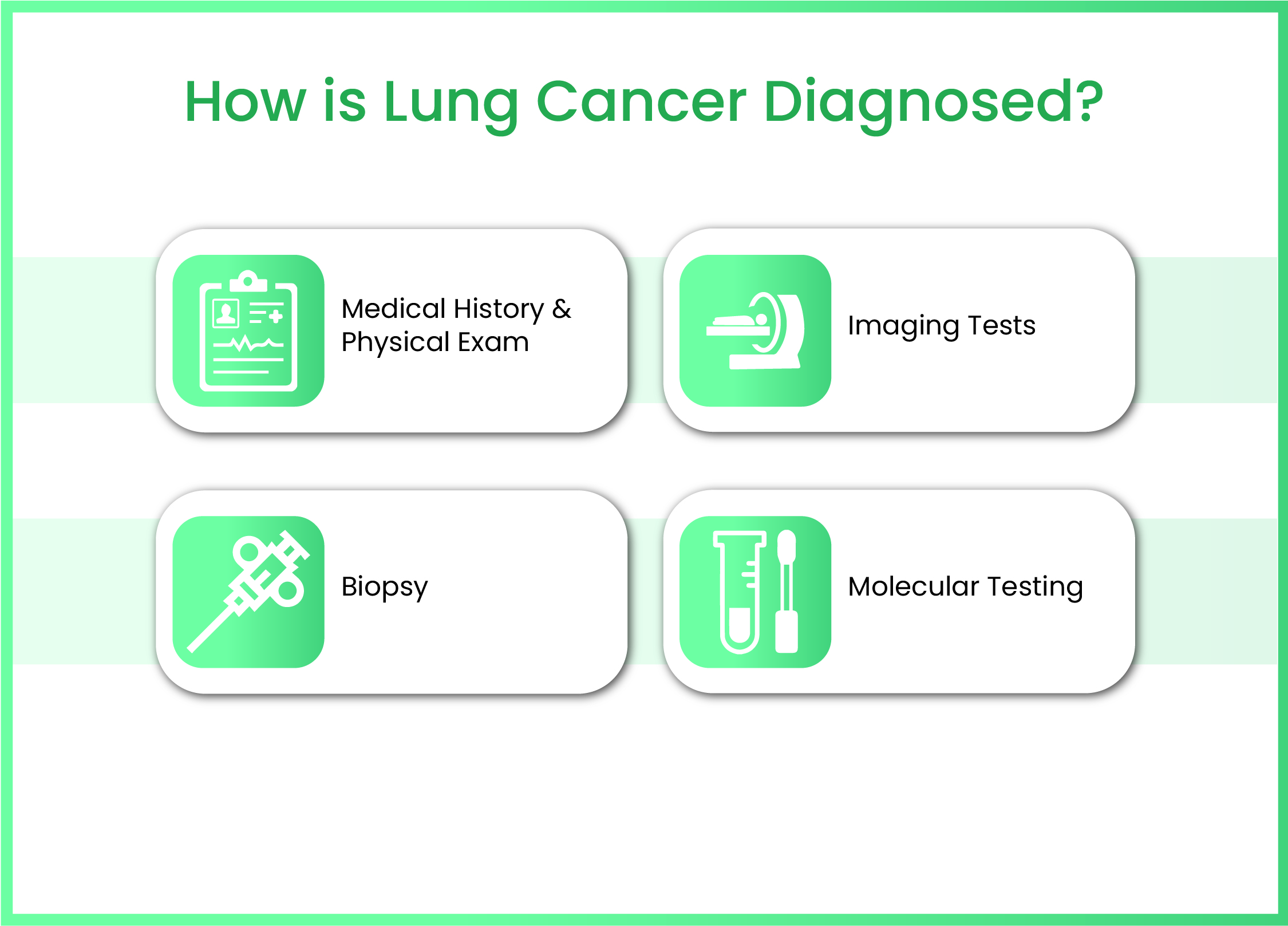
1. Medical History & Physical Exam
The first step in diagnosis involves a careful discussion between the patient and the doctor. The doctor asks about the patient’s symptoms, lifestyle habits (especially smoking), work environment, exposure to pollution or chemicals, and any family history of cancer. This conversation helps the doctor understand if there’s a need for further testing.
2. Imaging Tests
The doctor usually recommends imaging tests to get a closer look at the lungs. A chest X-ray is often the first test done. It can show a mass, shadow, or abnormal area in the lungs, which may raise suspicion of cancer. If anything unusual is found on the X-ray, the doctor may ask for a more detailed scan called a CT (computed tomography) scan. A CT scan creates clear images of the lungs from different angles and helps the doctor see the exact size, shape, and location of any lump or tumor. It can also show whether the cancer might have spread to nearby lymph nodes or other organs.
3. Biopsy
To confirm if the suspicious area in the lung is cancerous, a sample of tissue is needed. This process is called a biopsy. There are several ways to perform a biopsy, depending on where the tumor is located. One common method is bronchoscopy. In this procedure, the doctor gently inserts a thin, flexible tube with a camera into the airways through the nose or mouth. This allows the doctor to see the inside of the lungs and collect tissue samples from any suspicious areas.
4. Molecular Testing
In many cases, additional tests are done on the biopsy sample to check for specific genetic mutations or markers, such as EGFR, ALK, ROS1, or PD-L1. These are called molecular or biomarker tests. They help the doctor understand more about the cancer’s behavior and decide if targeted therapy or immunotherapy may work better than traditional treatments like chemotherapy.
Lifestyle Changes That Help
Whether you want to prevent lung cancer or you are recovering after treatment, healthy lifestyle changes can help:
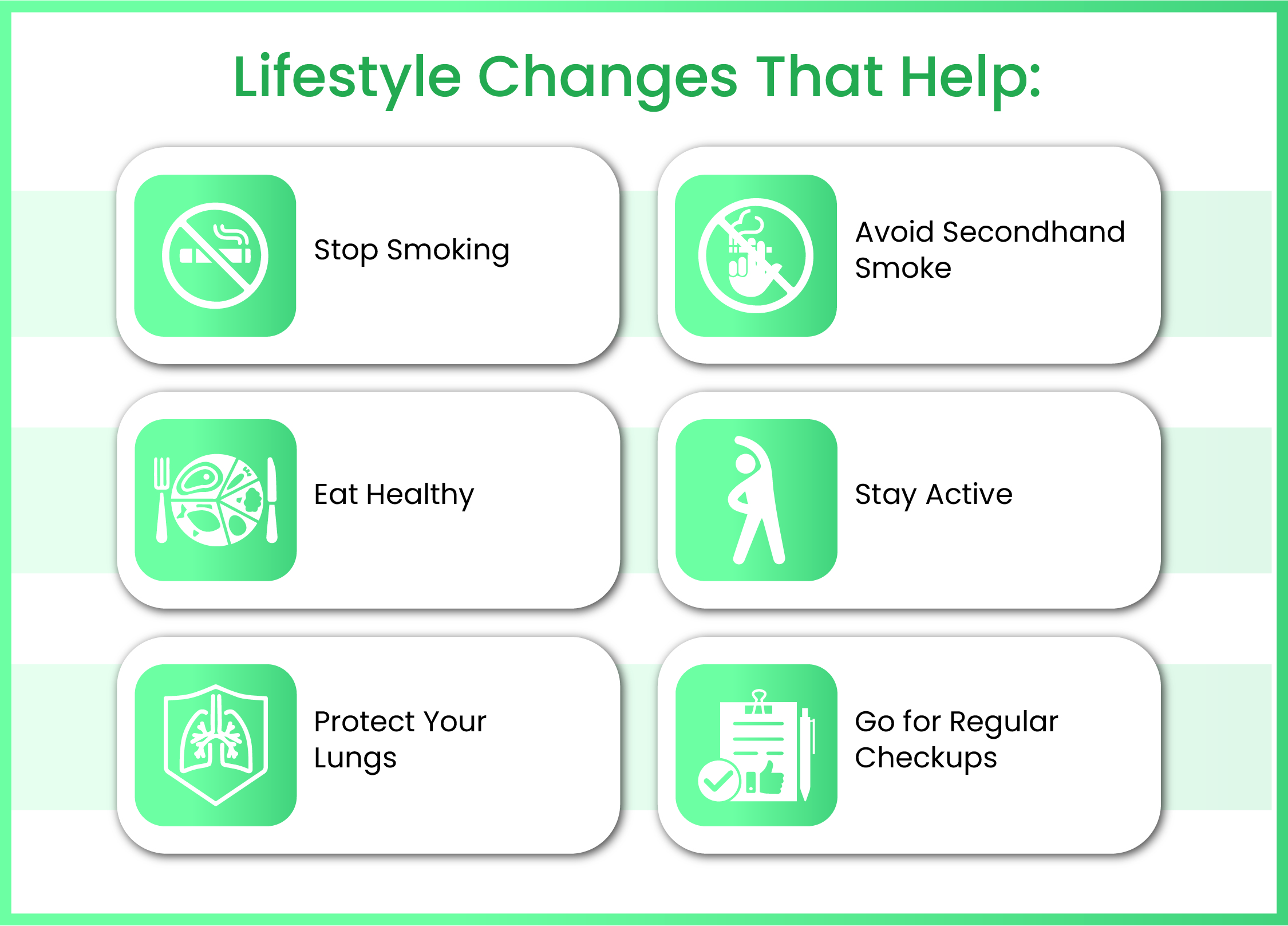
- Stop Smoking: It’s never too late to quit. This is the best thing you can do for your lungs.
- Avoid Secondhand Smoke: Stay away from smoke-filled areas and people who smoke nearby.
- Eat Healthy: Include fruits, vegetables, and whole grains. Avoid junk food.
- Stay Active: Even light exercises like walking can improve your lung health.
- Protect Your Lungs: Wear masks if you work in dusty or chemical environments.
- Go for Regular Checkups: Especially if you’re at risk.
Treatment Options for Lung Cancer
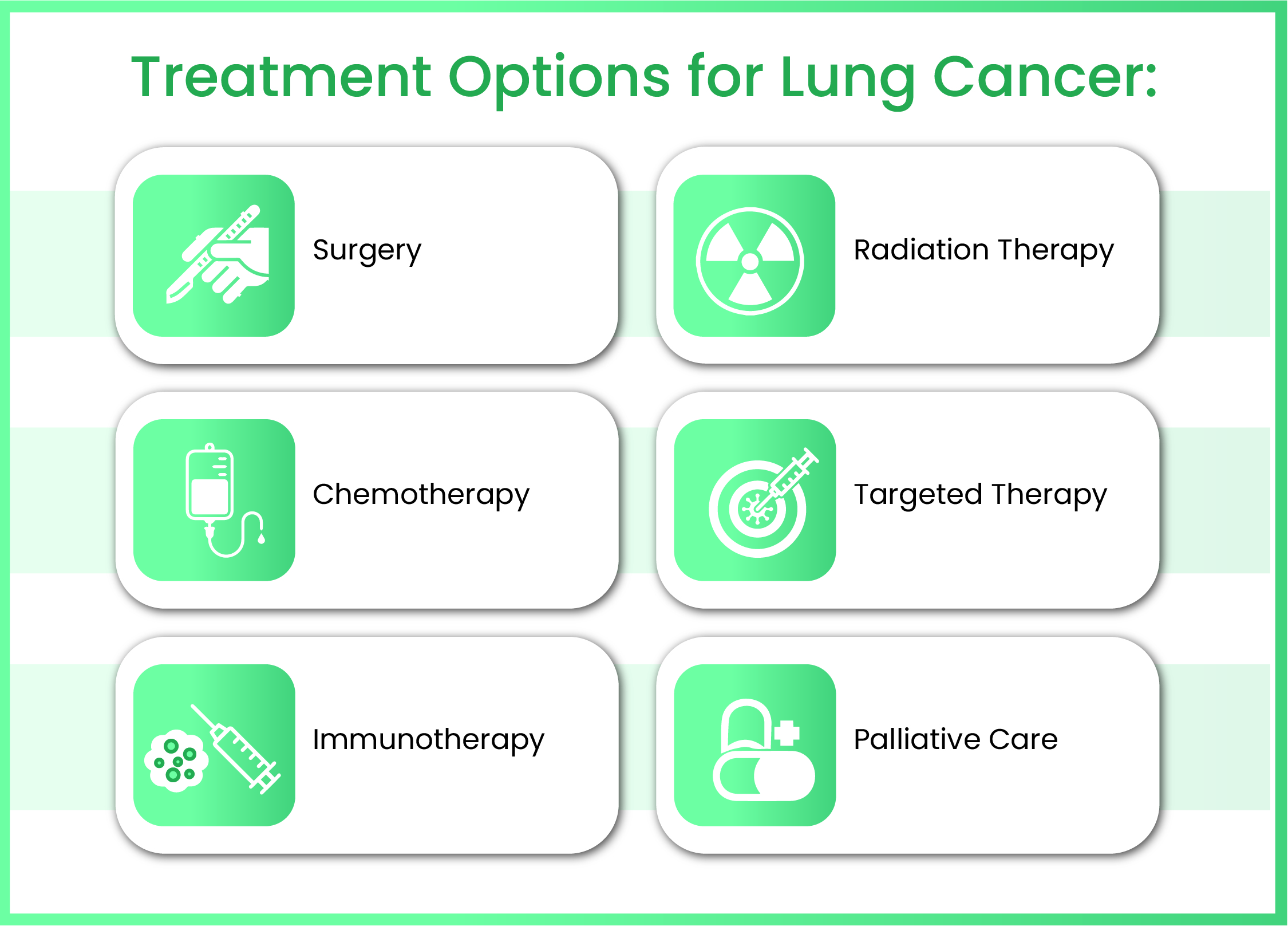
1. Surgery
One of the most common treatments for lung cancer is surgery, which is often used when the cancer is found at an early stage and hasn't spread beyond the lungs.
The goal of surgery is to remove the cancerous tumor from the lung along with a small portion of surrounding healthy tissue to ensure all cancer cells are removed.
Depending on the size and location of the tumor, the surgeon may remove just a small section of the lung (called a wedge resection), a larger portion (lobectomy), or in some cases, the entire lung (pneumonectomy). After surgery, patients are closely monitored and may need additional treatment to prevent recurrence.
2. Radiation Therapy
Radiation therapy is another major form of treatment used in lung cancer. It uses high-energy rays (similar to X-rays) to kill cancer cells or shrink tumors.
Radiation can be used alone or in combination with other treatments like surgery or chemotherapy. It is especially useful for patients who are not fit for surgery due to age or other health issues.
Sometimes, radiation is given after surgery to kill any remaining cancer cells. In more advanced cases, radiation can also help relieve symptoms like pain or difficulty in breathing.
3. Chemotherapy
Chemotherapy is a common treatment method where powerful drugs are used to kill fast-growing cancer cells in the body. These drugs are usually given through a vein (intravenously) or sometimes as pills. Chemotherapy can be used before surgery to shrink tumors, after surgery to kill leftover cancer cells, or as the main treatment if the cancer has spread to other organs.
While chemotherapy does affect healthy cells too, newer techniques and medications have made side effects more manageable.
4. Targeted Therapy
Targeted therapy has brought a breakthrough in lung cancer treatment. This type of treatment works by attacking specific genetic mutations or changes in cancer cells that allow them to grow.
For example, some lung cancers have mutations in the EGFR gene, ALK gene, or ROS1 gene. If tests show these mutations are present, then targeted drugs can be given to block the cancer’s growth mechanism without harming normal cells. These medications are usually taken as pills and often have fewer side effects compared to traditional chemotherapy.
5. Immunotherapy
Immunotherapy helps the body’s own immune system to recognize and destroy cancer cells. Cancer can sometimes hide from the immune system, but immunotherapy drugs remove these ‘shields’, allowing the immune system to find and attack the cancer.
This treatment has shown excellent results in certain types of advanced non-small cell lung cancer. It is often used when cancer does not respond well to chemotherapy or as a maintenance therapy to keep cancer under control.
Immunotherapy can be given alone or combined with other treatments based on the patient’s condition and the nature of the tumor.
6. Palliative Care (Supportive Care)
This form of treatment is not focused on curing the cancer but on improving the patient’s quality of life. It includes managing symptoms like pain, cough, breathlessness, and fatigue, as well as offering emotional and psychological support.
The goal is to make patients as comfortable as possible and help them live with dignity.
Dr. Reetu Jain is a highly experienced and compassionate lung cancer specialist in Mumbai, known for her patient-centric approach and expertise in treating complex cases. With years of clinical experience, she offers advanced and personalized care for all types and stages of lung cancer, including non-small cell and small cell lung cancers. As a leading lung cancer doctor in Mumbai, Dr. Jain combines the latest medical advancements—such as targeted therapy, immunotherapy, and minimally invasive treatments—with a deep understanding of patient needs. Her dedication to early diagnosis, accurate treatment planning, and holistic care makes her one of the most trusted names in lung cancer care across Mumbai.
Frequently Asked Questions (FAQs)
Yes, non-smokers can also get lung cancer. While smoking is the most common cause, many people who have never smoked still develop the disease. Exposure to secondhand smoke, air pollution, radon gas, or harmful chemicals at the workplace can also increase the risk. Genetics and family history can play a role too.
Lung cancer can be cured if it's diagnosed early, especially when the tumor is small and hasn't spread. In such cases, surgery followed by other treatments like chemotherapy or radiation can lead to complete recovery. However, for more advanced cases, the goal may shift to controlling the disease and improving quality of life. With newer treatments like immunotherapy and targeted therapy, even advanced lung cancer can now be managed effectively for several years.
Survival depends on the type of lung cancer, the stage at diagnosis, overall health, and how well the body responds to treatment. Some patients with early-stage lung cancer are completely cured and live a normal life. For advanced cases, treatments can help extend life and improve its quality
The side effects depend on the type of treatment given. Surgery may cause shortness of breath and recovery time varies. Chemotherapy can lead to fatigue, nausea, hair loss, and a weakened immune system. Radiation may cause skin changes, cough, or difficulty swallowing. Targeted therapy and immunotherapy usually have fewer side effects, though some patients may still experience fatigue, joint pain, or mild skin rashes.
While most lung cancers are caused by environmental factors like smoking or pollution, some types may have a genetic link. A family history of lung cancer can slightly increase your risk, especially if the relative was diagnosed at a young age. Genetic counseling and screening may help in such cases.


